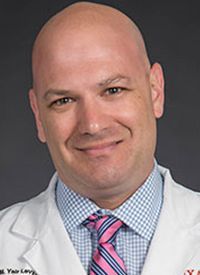Article
Naratuximab Emtansine Plus Rituximab Serves Unmet Need in Relapsed/Refractory DLBCL Treatment
Author(s):
Naratuximab emtansine plus rituximab had promising response rates while also improving patient well-being when used to treat diffuse relapsed/refractory large B-cell lymphoma and other non-Hodgkin B-cell lymphomas.
Moshe Y. Levy, MD

Naratuximab emtansine plus rituximab (Rituxan) had promising response rates while also improving patient well-being when used to treat diffuse relapsed/refractory large B-cell lymphoma (DLBCL) and other non-Hodgkin B-cell lymphomas (B-NHL), according to recent research presented at the 63rd Annual ASH Meeting and Exposition.
“Patients with DLBCL are treated with curative intent and oftentimes are cured. However, not all patients are cured, and patients with relapsed/refractory non-Hodgkin lymphoma and particularly aggressive lymphomas like DLBCL who are not candidates for stem cell transplant or CAR-T cell therapy have a particularly poor prognosis and there’s clearly a medical need for new treatment options,” investigator Moshe Y. Levy, MD, a hematologist at Texas Oncology-Baylor Charles A. Sammons Cancer Center, said when presenting the data.
The open-label, phase 2 study included 100 patients: 80 with DLBCL, 14 with follicular lymphoma, and 6 with mantle cell lymphoma. All participants were ineligible for stem cell transplant and were previously treated with 1-6 prior therapies.
Part 1 of the study was a safety run-in followed by expansion, where patients received 0.7 mg/kg of naratuxumab emtansine (an antibody drug conjugate) plus 375 mg/m2 of rituximab every 3 weeks (Q3W).
Then, Part 2 of the study involved only patients with relapsed/refractory DLBCL (n=66). Patients in this portion of the research were assigned to either cohort A, which was the Q3W regimen (n=33), or cohort B (n=30), where participants received 0.4, 0.2, and 0.2 mg/kg of naratuximab emtansine on days, 1,8, and 15 of a 21-day cycle plus 375mg/m2 of rituximab on day 1. Patients underwent 6 cycles of treatment with the option for extension.
“This study did include a lot of patients that are often excluded from DLBCL trials, and the inclusion criteria here were quite broad and very consistent with patients that we routinely see in our clinic,” Levy said.
The primary endpoints of the study were safety and overall response rate (ORR), and the researchers also evaluated pharmacokinetics and pharmacodynamics, as well as quality of life as described by the FACTLym quality of life questionnaire.
Follow-up was up to 1 year after a patient received his or her first dose on the trial.
The ORR in the efficacy evaluable patients with DLBCL was 44.7%, which included 24 patients (31.6%) who experienced a complete response (CR) and 10 (13.2%) with partial responses (PR). Nine patients (11.8%) had stable disease (SD) and 33 (43.4%) had progressive disease.
In Part 1, there were 16 patients with DLBCL who were efficacy evaluable: 6 were primary refractory and 10 were refractory to the last line. In this cohort, the ORR was 25%.
There were 30 efficacy evaluable patients in each of cohorts A and B in Part 2 of the study. Each cohort had an ORR of 50%, with 43.3% and 33.3% CR in cohorts A and B, respectively. Median duration of response (DOR) in the DLBCL patients was not reached (lower 95% CI, 12 months), and median duration of follow-up in patients who responded was 15 months (95% CI, 9-18 months).
For patients with follicular lymphoma, the ORR was 57%, including 5 CRs, 3 PRs, 3 SD, and 3 PD. At a mediation duration of follow-up of 21.8 months, average DOR was not reached (lower 95% CI, 19 months). In patients with mantle cell lymphoma, 4 of the 6 were efficacy evaluable. Two patients had CR and 2 had PD.
Regarding quality of life, patients with DLBCL in cohorts A and B who responded to treatment reported a clinically meaningful improvement of 3 points (SD 6.6) on the lymphoma subscale of the FACT-Lym QoL.
“Change from baseline until the last assessment up to and including the end of treatment was assessed in both responders and non-responders. On this index, 38% of the responders had a clinically important improvement of at least 7 points, versus only 8% of non-responders,” Levy said. “So we concluded that the treatment was associated with a significant increase in well-being in 38% of responders.”
Most observed grade 3 or 4 treatment-emergent adverse events (AEs) were hematologic events, which were “certainly quite manageable and oftentimes not as consequential,” Levy explained.
The most common AE was neutropenia (54%), which included 5% pneumonia or lung infection and febrile neutropenia in 4%. Eight patients discontinued therapy due to AEs, and of the 10 grade 5 AEs, only 2 were considered to be related to treatment. There were 3 liver-related AEs greater than grade 3, and 2 cases of non-serious neuropathy that was stage 3 or higher.
“Naratuximab (emtansine) plus Rituxan can certainly represent a new treatment option for relapsed/refractory non-Hodgkin lymphoma, especially relapsed/refractory DLBCL, which is still a particularly important unmet need for folks not candidates for potentially curative therapy with CAR-T or high-dose chemotherapy and autologous stem cell rescue,” Levy said. “Furthermore, the AE profile as well as efficacy of this treatment lends itself quite well to additional combinations to be explored.”
Reference
- Levy MY, Jagadeesh D, Grudeva-Popova Z, et. al. Safety and efficacy of CD37-targeting naratixumab emtansine plus rituximab in diffuse large B-cell lymphoma and other non-Hodgkin lymphomas – a phase 2 study. Presented at: 2021 ASH Annual Meeting; December 9-14, 2021; Atlanta, GA. Abstract 526.









